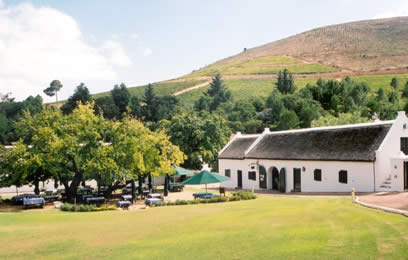
|
Dinner
with Rianie Strydom of Morgenhof Estate
First some background. Rianie started at Morgenhof in 1991
when she was still a student, working for the previous owners. The
Estate was purchased in 1993 by Alain
Huchon and Anne Cointreau-Huchon, and Rianie started working here full
time in 1994, assisting Jean Daneel. She took the job as chief winemaker in 1999,
having had control of her first vintage in 1998. She seems quite young
to have been entrusted with such a responsibility, but the results
speak for themselves. These are wines with poise and a fair amount of
elegance. What does Rianie think about Pinotage? ‘There are three
mentalities about Pinotage among South African winemakers’, she
explained. ‘There are those that love it, those that hate it, and
then those that try to do something with it.’ I guessed from this
answer that she’d put herself in the third category. What about cape
blends – red wines where Pinotage is used together with other
varieties? ‘I don’t like using it in blends’. And Syrah/Shiraz? ‘I don’t do it. Everyone’s planting
Shiraz at the moment. They are going over board, and there’s going
to be an oversupply problem in the future’. According to Rianie,
part of the success of Shiraz is because it is easy to work with.
‘It’s hard to go wrong with Shiraz; you get away with more’. I quizzed her about her thoughts concerning terroir, a
predominantly European worldview that is often derided in the new
world. ‘It’s an important concept’, she replies. ‘More grapes
that have been planted correctly are now coming into production in
South Africa. We concentrate Sauvignon on south-facing slopes and
Merlot on western and southern slopes. Cabernet is grown on eastern
and north facing slopes.’ Although she is a winemaker, she has
studied viticulture and takes a keen interest in it. Like many of the younger winemakers from the new world,
Rianie has broadened her outlook by stints in the classic European
regions. In 1996 she spent some time in Mersault (Burgundy), working
with Rene Monnier, and in 1997 she visited the Languedoc and spent 17
days in Italy. Then, in 1998 she did the vintage at Chateau de Franc
in Bordeaux. I asked her about the wines that she would regard as her
benchmarks, or inspiration, and the names she cited included Cheval
Blanc and Pichon Lalande Comtesse – clearly a leaning towards
Bordeaux. Rianie and her husband (who is also a winemaker) have their
own project: they’ve recently purchased 8.3 ha of land in
Stellenbosch that is currently home to fruit trees. They are planting
Merlot, Cabernet and Shiraz, with a view to making just one flagship
wine that will not be varietally labelled – again, the Bordeaux
influence showing here. What about the wines? First up is the Morgenhof Sauvignon
Blanc 2002. This is an impressive rendition of Sauvignon, made
from French clones. The ripe nose shows lots of grassy fruit. Lovely
balance here: nicely poised with lots of aromatic fruit. A hit. Next,
the 1999 Merlot, which is quite a structured wine, showing
attractive chalky, minerally notes. I like this: it’s not too
sweetly fruited and shows elegance and restraint. The Merlot
Reserve 1998 is much bigger and the fruit is much sweeter. There
are minty, tarry notes, and although it’s lush and opulent I find
there isn’t quite enough structure to keep it really interesting.
Production was 500 cases. The next wine is clearly quite ambitious, as
evidenced by the wax seal over the cork: it’s the 1998 Centnaire
Reserve. 2000 bottles of this Bordeaux-style blend were made, and
it spent 14 months in new oak. It’s a rich, ripe style with lots of
lush, smoky, tarry fruit. The palate is opulent and rich, with spicy
tannins and good acidity. Despite its size, it manages to stay
balanced. This was followed by the 1997 Premiere Selection (so
this was made before Rianie was in charge). This is a very attractive
structured, minerally wine with more than a whiff of Bordeaux about
it. It’s quite savoury with a touch of spice. Nice balance, too. We
finished with the 1999 Cabernet Sauvignon, which has a leafy,
minerally edge to the blackcurrant fruit. A fine set of wines overall
that justify the relatively high prices (by South African standards)
that are being asked for them. Stockists for Morgenhof wines include:
The Holland Park Wine Company - 020 7221
9614
Harrods - 020 8479 9595
The Haslemere Cellar - 01428 645 081
Stanton Wine Company - 01386 852
501
Wm Addison (Newport) Ltd - 01952 686 500
The Bristol Wine Company - 01173 730 288
For more details contact McKinley Vintners, UK agents (ph: 020 7928 7300 info@mckinleyvintners.co.uk) |
 Rianie Strydom is
the young winemaker at Stellenbosch winery Morgenhof Estate (pictured
right), whose
wines I’ve enthused about
Rianie Strydom is
the young winemaker at Stellenbosch winery Morgenhof Estate (pictured
right), whose
wines I’ve enthused about